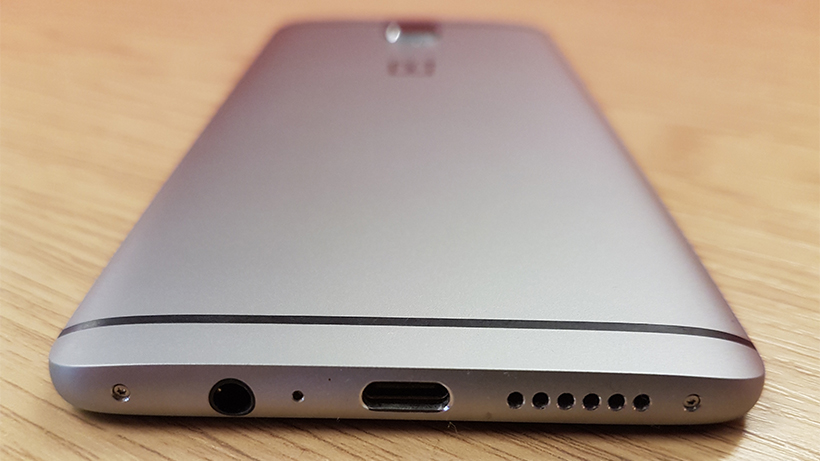
The ‘flagship killer’; a bold statement from a bold company. The Chinese tech firm OnePlus burst onto the smartphone circuit back in 2013 with its ‘never settle’ mantra, and an aim to deliver flagship devices at an affordable price.
Its third iteration, the OnePlus 3, shows the progress made in a short span of time and once more proves that smartphones don’t need to be expensive to be impressive.
Design
The OnePlus 3 represents a change in style from its predecessor; gone are the curved back and a sandstone case, replaced now by an all-metal unibody, sported by most smartphones. Personally, I think this represents a step backward, with the OnePlus 3 losing an element of uniqueness that set it apart aesthetically from the plethora of smartphones currently available.
Measuring 6.01 x 2.94 x 0.29 inches and weighing 158g, the phone is slightly thinner and lighter than the OnePlus 2. It does sport a rather unsightly bump on the back where the camera is situated, but this is only a minor complaint, with the phone being a comfortable size overall.
The OnePlus 3 is available in two colours: graphite and soft gold. While the colour choices only impact the back of the device, both of these colours look great and it’s almost a shame to cover them with a case.
The 5.5-inch display is one of the areas where OnePlus has made no changes. It features the same 1920×1080 (401ppi) display as the original OnePlus One did, but it now sports an optic AMOLED display.
The phone’s 1080p resolution doesn’t really hold up favourably when compared to other flagship devices, many of which offer 2K displays. However, the decision to stick to 1080p resolution means that the GPU is under less stress at least, which can really make a difference when using graphically-demanding apps.
However, the display of the OnePlus 3 falls short in terms of the colour reproduction, not able to matching the standards of other devices such as the Samsung Galaxy S7. It’s a similar story too with the contrast ratio, with this also comparing unfavourably to a number of rival devices. Since its launch OnePlus has released an update allowing support for sRGB rendering, which, while not completely fixing the issue, does greatly improve the situation.
Another way in which the OnePlus 3 falls below its competitors is with regards to its speaker. OnePlus opted to include a single speaker, rather than the usual dual-speaker setup, with this having a grave effect on audio quality unfortunately.
Features
OnePlus claim to have the fastest fingerprint reader available, claiming it can read fingerprints in just 0.3 seconds, which is certainly impressive. When using the scanner, it’s clear that it is both fast and accurate.
The OnePlus 3 comes in only one storage option – 64Gb – and has no microSD card slot to increase storage. Unfortunately, the Operating System (OS) takes up around 12Gb of space, leaving you with 52Gb of usable space. While this may disappoint some people, for a large majority of users 52Gb is plenty of space for games, music, movies and more.
Performance
Everyday tasks such as watching YouTube videos, listening to music, texting and checking emails were no problem for this phone and with 6GB of RAM, multitasking becomes a breeze. Demanding games like Implosion and CSR racing 2 looked excellent on this screen and ran without a hitch too.
While the Apple iPhone 7 and Samsung Galaxy S7 seem to operate quicker and more smoothly than the OnePlus 3, it’s still a very strong performer.
One minor issue present in the OnePlus 3 is a small amount of touch latency, as it can sometimes take a while for the phone to register input. However, OnePlus has plans to fix this in their next update.
Battery
This is one area where the ‘never settle’ mantra comes into question, because the battery size is 3,000Mah, which is smaller than the OnePlus 2. Granted the Snapdragon 820 is more energy efficient than its predecessor, but it’s still a step down from the OnePlus 2.
Quick charging has been utilised by smartphones for a while, but the OnePlus 3 takes this one step further with its own ‘dash charge’ – based off its parent company OPPO’s VOOC charging.
What this means is it pushes 4A instead of 2A that other quick-charging solutions do, and the device is able to charge from empty to 60 per cent in just over 30 minutes. Furthermore, unlike some other quick-charging solutions, the phone doesn’t seem to overheat much.
It claims to do this by shifting the power management system and heat dispersion elements to the Dash Power Adapter, which allows it to keep charging at full pace while it’s being used. I have found the phone to last the whole day with standard usage, which is good, especially when compared to similar devices.
Camera
The OnePlus 3 utilizes the Sony IMX298 sensor for the main camera on the rear of the phone, which is able to deliver some excellent shots. The camera is capable of taking 16MP photos, and has LED flash at its disposal.
The camera is able to take images at 4K resolution and record video at 4K (and even 1080p at 60FPS). The front facing camera also boasts an impressive sensor, as it uses the same one found on the rear camera of the iPhone 6s.
Price and conclusion
At launch the OnePlus 3 costs £309, but at the time of writing it has risen to £329. While the price of OnePlus phones has been steadily increasing over the years, they remain at a competitive price. It’s essentially a flagship phone for half the price. If you’re willing to overlook the minor flaws, then this phone is a must buy if you want a great phone without breaking the bank.









